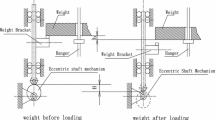Conclusions
-
1.
The error of dial balances with loose weights, which increases in each range with a rising load, is due to the displacement of the apex of their loose weights lever's end knife edge from the line running through the apexes of the bearing and the load-carrying knife edges.
-
2.
These errors are eliminated by adjusting the height of the loose-weights lever's end knife edge.
-
3.
Investigations of the relationship (2) shows that for the same vertical displacement of the end knife edge the error increases with a rising tare effort P0 and mass P of loose weights, and a rising maximum tilt angleϕ max of the loose-weights lever.
-
4.
The error due to the lack of coincidence between the lever's center of gravity and the rotation axis should be compensated by changing the position of this center of gravity with respect to its height.
Similar content being viewed by others
Literature cited
A. L. Shneiderman, Izmeritel. Tekh., No. 2 (1959).
Additional information
Translated from Izmeritel'naya Tekhnika, No. 10, pp. 18–20, October, 1969.
Rights and permissions
About this article
Cite this article
Bocharov, V.A. Compensation of dial-balance errors contributed by loose weights. Meas Tech 12, 1351–1354 (1969). https://doi.org/10.1007/BF00994850
Received:
Issue Date:
DOI: https://doi.org/10.1007/BF00994850




